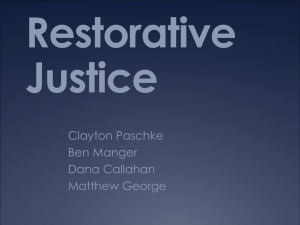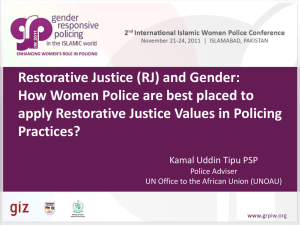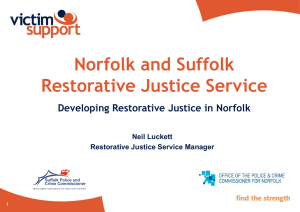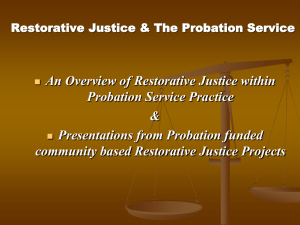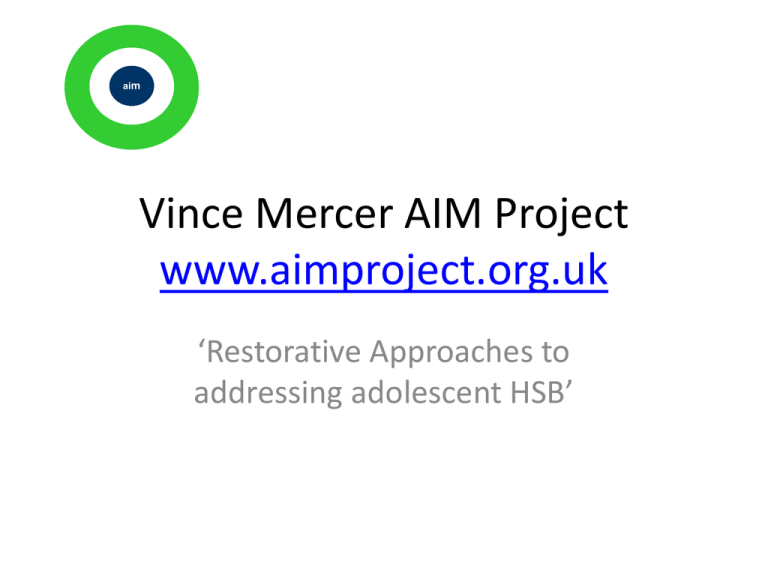
aim
Vince Mercer AIM Project
www.aimproject.org.uk
‘Restorative Approaches to
addressing adolescent HSB’
What I hope to cover….
• The background to AIM restorative work in
child/adolescent SHB cases
• Strengths and weaknesses of this approach
• The importance of assessment
• Practice standards
A long walk across the street….
A combination of two elements
• AIM PROJECT
• Focus upon creation of
good practice tools
• Rooted in combination of
practice/research
knowledge
• Emphasis upon
assessment
• Need to address HSB in
holistic sense, inclusive of
victim/family perspective
• GM YJT Family Group
Meetings Project
• Focus upon
serious/complex cases
• Emphasis upon
engagement with social
ecology of offender
• Model of FGM with
planning needs for both
Victim and Offender
RJ in HSB?????
• Nightmare
on
Restoration
Street……..
Exercise 1
• In Groups list what are the types of restorative
nightmares we would wish to avoid in cases of
HSB when attempting to bring ‘offender’ and
‘victim’ together in dialogue.
• Group these under the headings;
• Victim Nightmares
• Offender Nightmares
• Facilitator Nightmares
Exercise 1.2
• On the flip chart sheet indicate whether they
are ‘nightmares’ to be identified in
assessment, addressed in preparation, or
managed in the meeting
Area’s of restorative
potential…..
• Familial/ relational context
•Previous exclusion of real victim perspective
•Possibility to link into victim support service
•Benefits to offender intervention programme
•Congruence of interest between
victim/offender/family
Relational context
• In cases of youth SHB
over 96% of offender
have some form of
relationship with victim
• In 40/50 % cases
intrafamilial (Ryan)
• Simons Hackett’s research
on family responses to yp
displaying SHB 27% were
wholly intrafamial and a
further 27% were both
intra and extra familial
(2012)
Rationale for including Family
• Parents are a source of internal working models for
yp
• Parents key role models; relationships/ problem
solving
• Family values shape yp values; gender entitlement
• Its often where the victim is….
• Critical role in assessment and care planning
• Continuing influence on yp therefore have a key role
in supervision
• Most yp return to family
Issues that parents may bring
• Need to have their ‘story’ heard what it was like for them
• Shock, Trauma, Shame, Anger and Guilt leading to
possible invitations to deny/minimise/ reject/marginalise
(Letournea 2009, Duane 2002 after Hackett S 2012)
• Understanding why he ‘did it’
• Information on prognosis; son’s future risk.
• Information about impact upon victim
• What they can do?
• Outlining additional problems/ wider relational fracture/
self blame/ blame other parent/victim
Consequences of failing to engage parents
and carers
•
•
•
•
•
•
•
Family left isolated
Resentment of and resistant to agencies
Minimising and denial of the problem
Rejection/ marginalisation of the young person
Constricts assessment and planning
Lack of focus on vulnerable siblings and or other victims
Increased risk of treatment drop out / recidivism; recent
outcome research supports the view that failure to
engage /involve families seriously impairs potential for
positive outcomes (Letournea 2009 after Hackett S 2012)
Inclusion of the Victim?
• Not directly but through
Victim Awareness/Impact
work to increase empathic
response; National survey of
sex offender interventions in
the US indicated that 87-95%
included victim empathy work
• Some limited involvement of
victim experience through
‘Victim Clarification’ Model
• Anxiety about being
‘compromised’ in approach to
work with offender if ‘too
close’ to reality of victim
experience
• A limited conception of harm
• Initial focus upon ‘safe’ cases
in developing UK restorative
practice
• Fear of doing more harm.
Links into victim services…an
unfinished story…
• Creation/expansion of
SARC’s in England/Wales
• Focus upon good forensic
evidence gathering to
bridge ‘the justice gap’
• Support/counselling/advo
cacy to victims
• Hospital based
• Poor partnership with
community services
• Strong sense of victim
rescue/crusade
• Reluctance to recognise
the complexity of
relational context
• ‘silo’ working and fear of
‘contamination’ with
offender perspective
Desistance Studies
•
•
Traditional focus upon why
people offend?…more
recently on how/why
people stop?
Key desistance factors;
Maturation,
Stable
employment/training/
Attachment to strong
positive social bonds
,(relationships/family).
Transformation of
personal identity
• Maruna (2001) identified
change in personality/self
concept ‘I did a bad
thing…now I can do a good
thing…’
• But the formal CJS offers
little in the way of ‘rituals of
redemption’ only rituals of
stigmatisation/condemnatio
n
Shame on you….
• Shame is not toxic....it is
a mark of our
humanity…’
• Schneider,C.D. ‘Shame
Exposure and Privacy’,
Norton NY, (1992)
Strategies to avoid shame lead to..
• Complete or partial
denial of the harm
• Attempts to mimimise,
justify or deny the
action
• Blaming of others
• Attrition of sense of self
worth and or capacity
to change
• Withdrawal
• Attack others…
• Attack self….
Importance of shame management
• Alan Jenkins (1998)
recognised that one of
the greatest inhibitors
to young peoples
engagement in
therapeutic work on
HSB is the intense
feeling of shame
• Ruth Mann (2012)
identifies shame as a
significant factor
leading to the
suppression of
empathic responses by
offenders to their
victims of sexual harm
Attack
Self
Compass of Shame ;
Derived from D.L Nathanson
‘Shame & Pride;Affect,Sex and the
birth of self’ Norton, London (1992)
Engage
Response
At experiencing an acute sense of
shame an offenders response may be
described in one of four cardinal
points of the shame compass…
Attack
other
Withdraw
Stigmatising shame vs Reintegrative
approaches
• Braithwaite's concept of
restorative integration,
not stigmatising
• Shame
acknowledgment and
expression in a
respectful/ ethical
manner before those
who matter most
The wider factors the therapeutic worker (with Darren)
identified which the restorative approach delivered
•
•
•
•
•
Emotional regulation
Emotional expression
Empathy
Perspective taking
Openness to victims feelings,
thoughts and experiences
• Future focus
• Family positions
• Acceptance of responsibility
remorse expression
•
•
•
•
•
Shame management
Appreciation of wider impact
Awareness of impact on family
Forgiveness? Self forgiveness?
Understanding meaning and
actuality of victimisation
• Understanding why specific
individuals were targeted
• Facilitates partnership work with
family
• Plan for release/ Victim
perspective on parole
Area of cross over/mutual interest
• VICTIM
• Need to be believed and
acknowledged
• Disown responsibility for
offence
• To accept and
acknowledge violation
caused by offence
• To share
acknowledgement of the
harm/impact of the
offence
• OFFENDER
• Need to address
denial/minimisation
• Own responsibility for
offence
• To appreciate and
acknowledge the extent
of harm
• To accept the impact of
the harm on others
And more…
• VICTIM
• Creation of a safe
environment in which to
function
• Restoration of sense of
self not defined by
victimhood
• To explore impact in
relational
context/restoration of
role and relationships
• To receive apology?
• OFFENDER
• Creation of a safe
environment in which to
safely function
• Creation of sense of self
not defined by offence,
or label
• To understand impact in
relation context/creation
of safe role and
relationships
• To receive forgiveness?
Pressner and Lowencamp said…
• ‘The more the danger that the crime situation
entailed for the victim, as in cases of intimate
violence, the more urgent is the need for
standard assessment’
• Restorative Justice and Offender screening- Jnl
of Criminal justice Vol 27 1999
The framework is…
• To assist in structured restorative practice decision
making… informs preparation;
• Intention is to widen and inform the potential of
practice/ not deny and shut it down
• It has research/evidential elements but largely based
upon 10+ years of patient practice and reflection
• Fits into requirements of current Best Practice
Guidance and assists with professional development
of practitioners
It requires…
• Some flexibility/sensitivity in application and
interpretation
• A level of restorative skill/insight/knowledge
beyond basic restorative practice
• Layered on top of an offender ‘criminogenic’
assessment
• Working to Best Practice standards (HO 2012)
NOS 2013, AIM Best Practice Guidance in
cases of HSB
The HSB RJ Framework is
Changing…..
• Being revised and updated
in line with ongoing
research/practice
knowledge
• Extended to cover all
SENSITIVE and COMPLEX
cases (as per Best Practice
Guidance)
Issues not covered….
•
•
•
•
•
•
Level of restorative skills
Adaptation/amendment of restorative models
Agency competence to support practitioners
Victim led not offender led referral route
Engagement with victim services
On going research and EU DAPHNE RJ and SV
Project
An illustration…
• Opening the box…. Jo’s
account
References
•
•
•
•
Hackett, S Balfre, M and Masson, H
(2012) ‘Family Responses to Young
People who have Sexually Abused;
Anger, Ambivalence and
Acceptance’ in Children and Society
AIM Project ‘ Revised Assessment
framework for restorative
approaches to SHB’ (2013)
AIM Project ‘ Best Practice series’
Restorative Meetings and SHB’
(2007) www.aimproject.org.uk
Mercer, V, Henniker,J: ‘Restorative
Justice; Can it work with young
people who sexually abuse?’ in
‘Working with Children and Young
People who sexually abuse; taking
the field forward’ Ed Calder M,
(2007)
• Mann RE, Burnett,G ‘Empathy,
Cognition and sexual reoffending’
NOS Management Service 2012
• Maruna S, ‘Making Good’ (2001)
and ‘Virtue’s Door unsealed and
never sealed again; Redeeming
,Redemption and the seven year
itch’ (2009) in Contemporary
issues in Criminal Justice Policy.
• Jo’s Story in ‘Resolution’ Ed 40,
Spring 2011, Restorative Justice
Council
• Braithwaite J, 1989 ‘Crime,
Shame and Reintegration’



